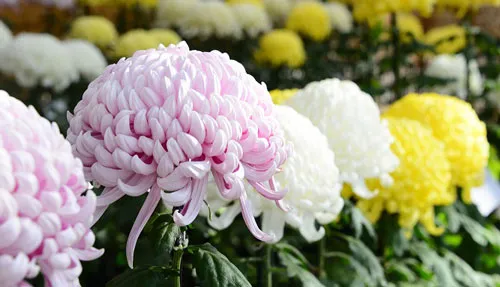In Japan, the chrysanthemum is recognized as the national flower because it is the Imperial Emblem of Japan. It is printed on the cover of a Japanese passport, you can see it in Japanese embassies abroad, and Shinto shrines. It is also displayed on diplomatic buildings and any other place where the symbolic state authority of His Majesty the Emperor should be demonstrated. The origin of this symbol dates back to the time of Emperor Go-Toba (1180 – 1239), with His Majesty choosing the flower as his personal emblem.
Here’s an article with more information on Japan’s many beautiful seasonal flowers.

How Chrysanthemums Became Japan’s National Flower

Chrysanthemums first came to Japan from China in the fifth century. Chrysanthemum cultivation began in Japan during the Nara and Heian periods (710-1185). The flower was planted throughout Japan at that time. It then steadily gained popularity in the Edo period (1603-1868).
In Japan, more than 350 types of 200,000 varieties that are known in the world can be found. The flower was adopted as the Imperial Seal of Japan. Some clans then started cultivating the flowers to indicate their support and good relationship with the Imperial Family.
Chrysanthemums present the noble class and the fall. This is why Japan hosts a festival in honor of the chrysanthemum in October/November. This festival happens on the grounds of the Yasukuni Shrine and the Meiji Shrine.
Present-day Chrysanthemums
You can find Japanese restaurants that use culinary quality chrysanthemums to decorate food, and the flower remains a common motif in traditional Japanese arts such as ikebana, porcelain decoration, and kimono design.
The official day of the chrysanthemum is known as Chōyō, which literally means ‘Chrysanthemum Festival’ (Kiku no Sekku), and it is one of the five sacred events in Japan. It is usually celebrated on the 9th of the 9th, September 9th. A ritual is performed both in Shinto shrines and in Buddhist temples. The festival then focuses on the desire for longevity and is often enjoyed by drinking chrysanthemum’s sake.
The chrysanthemum is an ornamental flower full of symbolism in many countries. In Asia it represents longevity, so it is also a flower that is widely used in rituals. When the flower is yellow, it symbolizes sunlight, heat, and, moreover, represents joy, happiness, intelligence, and energy.
Flower-Viewing Tour Packages
・The Best of Japan Private Tour Package 7 Days
・2025 The Classic Japan Tour package 8 Days
・8-Day Small Group Tour Golden Route Japan in Cherry Blossoms Season
Your Japan Tour
As seasoned Japan experts, we create perfect Japan package tours including guides who can tell you all about the history of Japan. Check out our group tours and private tours, or contact us to start planning your unforgettable holiday to this fascinating country. Japan is full of once-in-a-lifetime experiences, culture, history, nature, and delicious food!